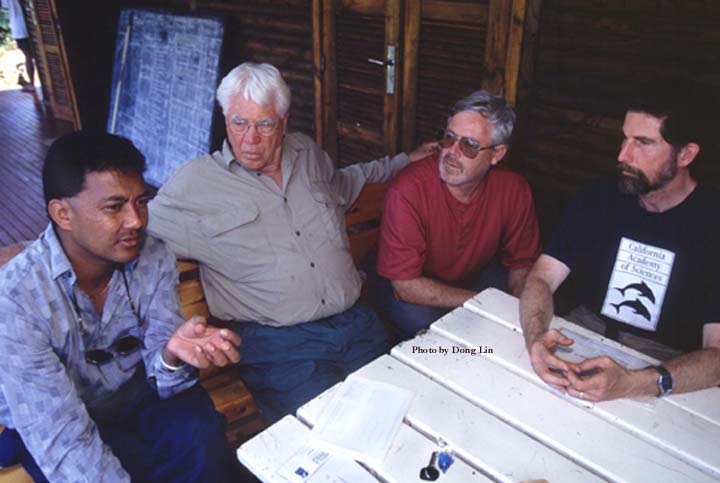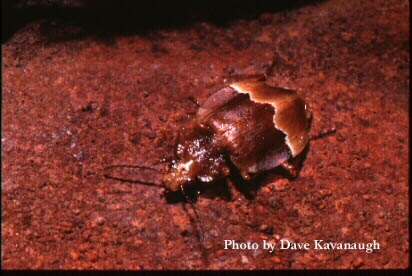|
||||
FIRST CAS MADAGASCAR EXPEDITION
 |
| Group photo in front of National Park Headquarters in the town of Ranomafana. Front row: Dr. Michael Irwin (Academy Fellow), Jean Samuelson Randrianarisoa (student), Marie Jeanne Raherilalao (student); second row: Dr. Evert I. Schlinger (Academy Fellow), Dr. Norman D. Penny (Sr. Collections Manager), Dr. David H. Kavanaugh, Sr. Curator), Tina (logistics support - ICTE), Darryl Ubick (curatorial assistant); third row: Jere Schweikert (curatorial assistant), Dr. Charles E. Griswold (curator and expedition leader), Keith Howell (editor - California Wild), and Jocelyn Rakotomalala (Park Director) |
 |
Amongst
the invertebrates also, isolation has created conditions for development
along independent pathways, often preserving primitive characteristics
which have become modified elsewhere in the world. For example, about
80% of this island's spiders can be found nowhere else. By studying
the flora and fauna of Madagascar we hope to better understand several
biological concepts, such as a better understanding of
evolution, dispersal timing and mechanisms, niche partitioning, and
adaptive radiation. These studies also have the benefit of allowing
us to better understand the biodiversity of this island for comparisons
with the biodiversity of floral and faunal elements elsewhere. |
| Calibrating global positioning devises on front porch of research cabin. From left to right: David Kavanaugh, Jere Schweikert, Keith Howell and Norman Penny. |
Assisted in part by a grant from the Oracle Foundation and an anonymous donor, the Academy's Executive Director and its Trustees determined to make a major commitment to the Madagascan survey. Between 30 March 1998 and 5 May1998 five entomologists from the California Academy of Sciences travelled to Madagascar accompanied by the staff photographer, Dong Lin, and the editor of California Wild, Keith Howell. The entomologists were Dr. Charles Griswold, a specialist on spiders and leader of the expedition; Dr. David H. Kavanaugh, a specialist on carabid ground beetles; Dr. Norman D. Penny, a specialist on lacewings, ant-lions and planthoppers and departmental collections manager; Darrell Ubick, a specialist on spiders and assistant to Dr. Griswold; and Jere Schweikert, curatorial assistant and a generalist who helped all participants gather specimens. Dong Lin was there to document the scientists' activities visually, and Keith Howell wrote about Madagascar, its people and its wildlife from a journalist's point of view. Two students from the University of Antananarivo, Marie Jeanne Raherilalao and Jean Samuelson Randrianarisoa were along to learn more about the groups being studied and collecting techniques. The team was studying the arthropod fauna of Ranamafana National Park along the eastern escarpment of the island.
 |
At the same time that the main group was focusing attention
on Ranamafana National Park, two Research Fellows of the Entomology
Department, Dr. Michael Irwin and Dr. Evert I. Schlinger, were moving
from point to point in southern Madagascar, setting up flight intercept
traps to capture stilleto flies and acrocerid flies, the latter being
parasites of spiders. Their collections were examined in the field
and specimens of interest to them were selected out. The rest
of the specimens captured were turned over to the Entomology Department
for preparation for other researchers' projects. |
| Discussion of expedition expectations on front porch of research cabin. From left to right: National Park Director Jocelyn Rakotomalala, Evert I. Schlinger, David H. Kavanaugh and Charles E. Griswold. |
| Almost
every day from seven in the morning until nine at night, the researchers
turned over rocks and searched through the detritus of the forest
for their elusive prey. To find their prey, the researchers used a
number of intriguing techniques: sieving leaf litter, scratching the
bark of trees, revealing spider webs by dusting them with corn starch,
light traps at night, pitfall traps in the ground, and large Malaise
nets which funnel flying insects into collecting jars, and the trusty
sweep nets.
. |
 |
| Mormolycina oberthuri, one of more than 220 species of ground beetles (Carabidae) found at Ranomafana National Park |
The group encountered a period of unusually high rainfall during their stay: on two occasions rains were unceasing for four days each. This environment was teaming with land leeches. Despite these minor distractions, good results were obtained. Now that the team and the specimens collected are back in San Francisco, the arduous task of sorting and identifying the thousands of specimens begins. "We probably collected about 5,000 spiders, representing around 300 species, and perhaps half of them are new, undescribed species," says Griswold. "But it will take years, generations, before they will all be named and fully inventoried."
Acknowledgements: Text by Keith Howell and Norman Penny. Photos by David Kavanaugh and Dong Lin. Web page layout by Julie Parinas and Norman Penny. Edited by David Kavanaugh and Charles Griswold.
Updated: 11 May 2001
To Notes on Madagascar Neuroptera Fauna




